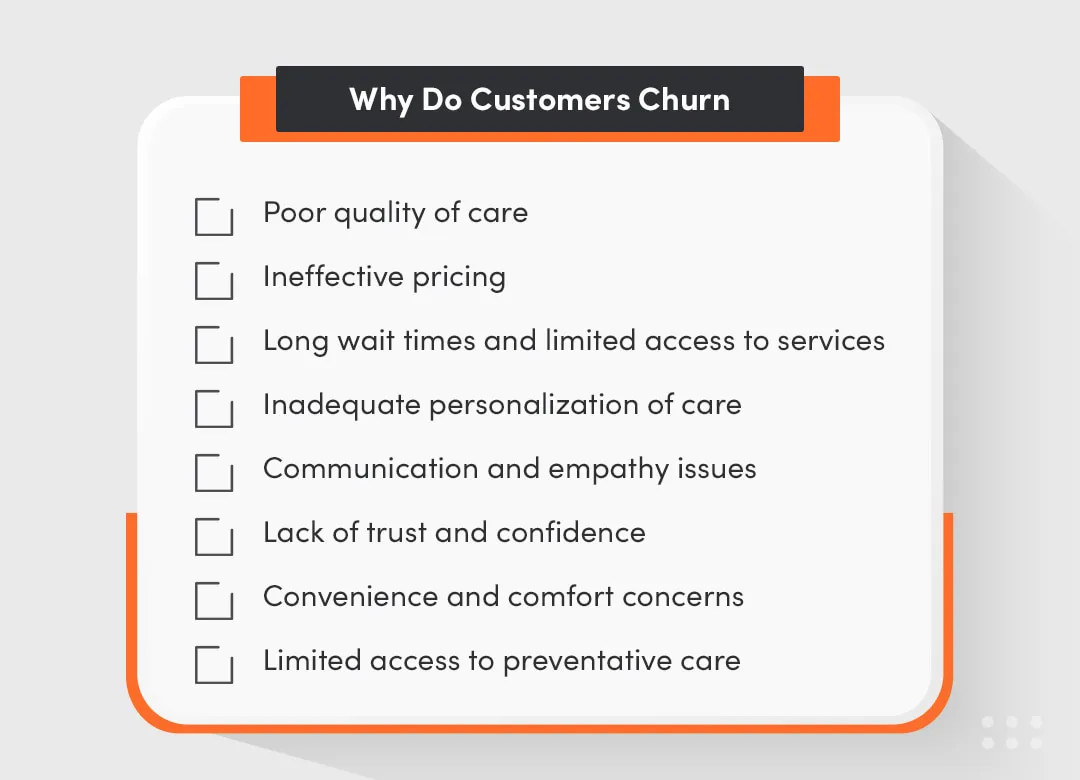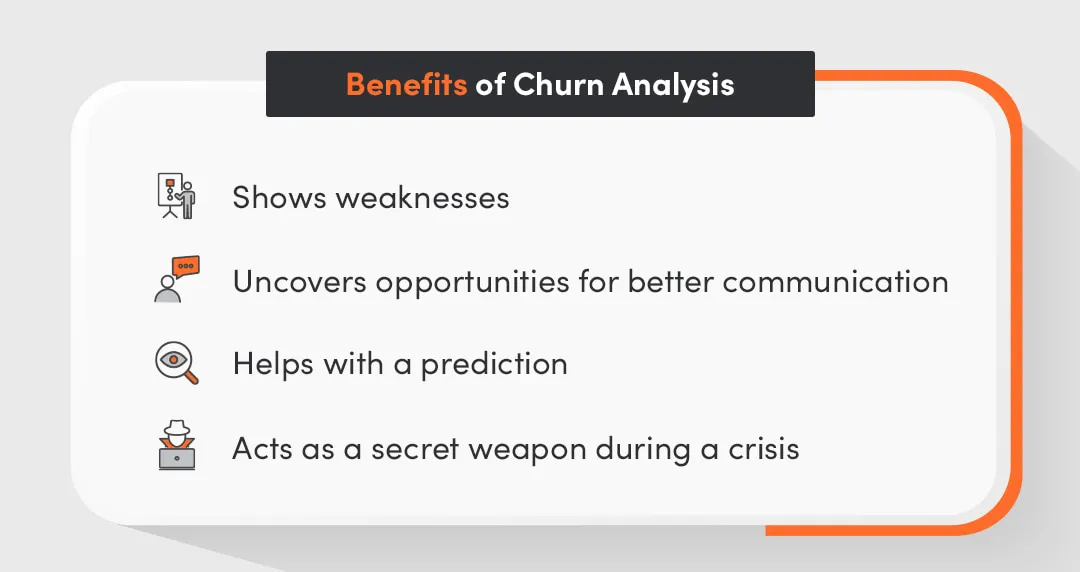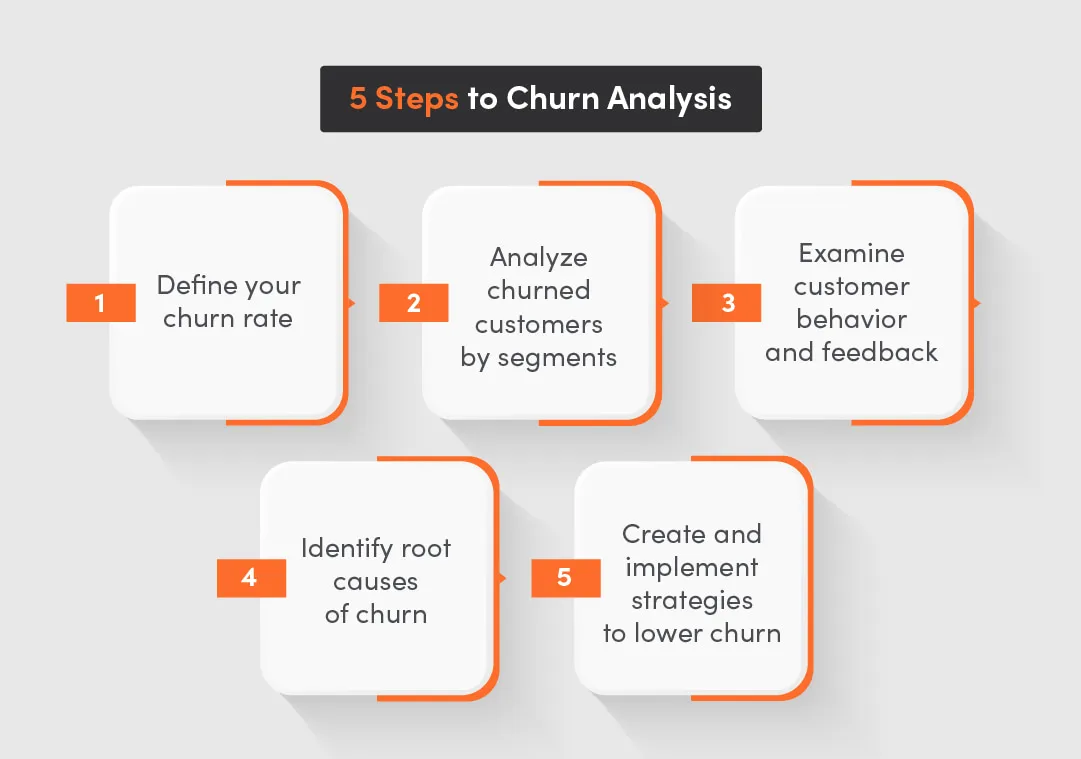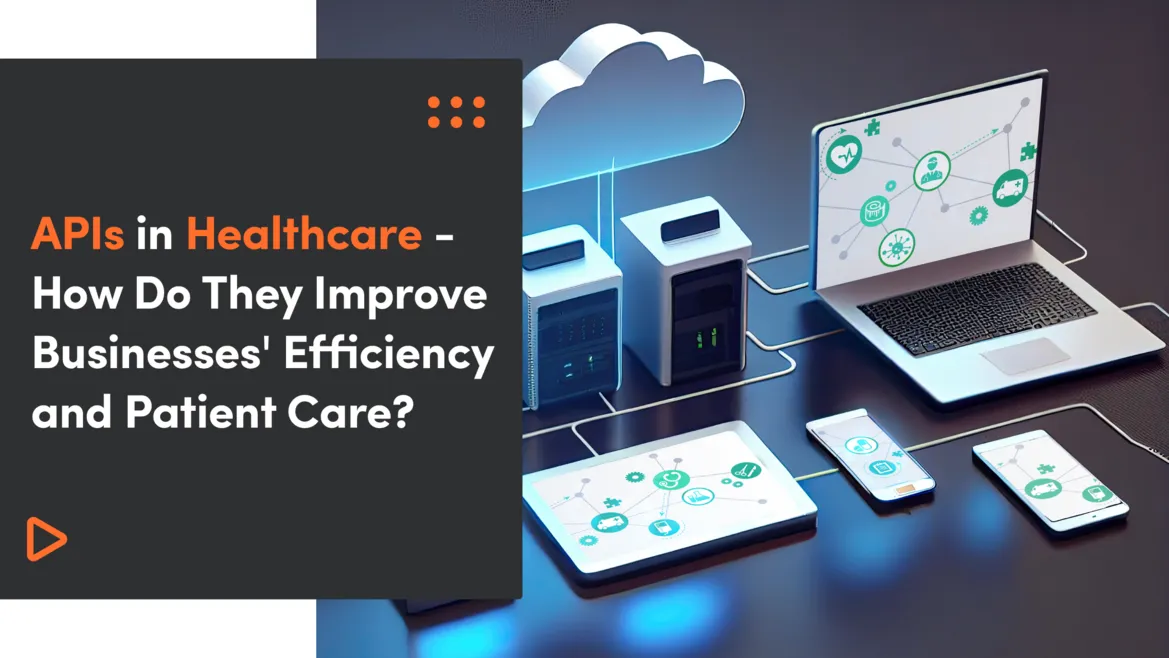As a healthcare professional or administrator, you're aware of the challenges associated with retaining patients. Customer churn, often referred to as customer attrition, can take a toll on your practice's success. High churn rates not only impact revenue but also raise concerns about the quality of care provided. Moreover, in an age of online reviews and social media, dissatisfied customers can quickly share their negative experiences, which can damage the reputation of your healthcare practice.
Remember, your business profits largely depend on your ability to retain existing customers. In fact, According to Zippia, a mere 5% increase in customer retention can yield a substantial boost in profits ranging from 25% to a staggering 95%.
Indeed, the rising customer attrition rate can be a cause for concern in any business. The prospect of losing valuable customers and the potential consequences on your business's bottom line can be daunting. However, it's crucial to remember that a proactive approach can make a significant difference.
Customer attrition is not an uncommon challenge, and many businesses sometimes face it. The key is to address the issue strategically and proactively. This article will provide you with valuable insights and practical strategies that can be implemented by healthcare providers of all sizes, from individual practitioners to large healthcare systems, to address this issue head-on.
To begin, we urge you to take a proactive approach by assessing your current business churn rate. Understanding the extent of the problem in your healthcare setting is the first step toward developing an effective solution. With this knowledge in hand, you'll be better equipped to apply the strategies outlined in this article to your specific business needs.
What you will learn from this article:
- How can I conduct customer churn analysis?
- How can I identify customer churn and stop customers from leaving?
- What is the correlation between revenue and churn reduction?
- Possible strategies and practices to reduce customer churn
- What is churn analysis and why is it important?
- What is customer churn prediction using machine learning and how does it work?
- What are the best tools that can potentially be used for healthcare businesses to analyze churn?
Why Do Customers Churn and How to Stop Them From Leaving?
To effectively address customer churn in healthcare, it's crucial to understand why patients may leave healthcare brands or services. Identifying key factors that contribute to churn requires a thoughtful analysis of both quantitative data and qualitative insights. Although the reasons customers churn can be personal and unique to each individual, they often fall into some common categories. Let’s explore each below.

Poor quality of care
If patients perceive a decline in the quality of medical care they receive, such as frequent medical errors, misdiagnoses, or ineffective treatments, they may consider seeking care elsewhere.
Ineffective pricing
High healthcare costs, unexpected medical bills, or dissatisfaction with insurance coverage can prompt patients to explore alternative healthcare options.
Long wait times and limited access to services
Patients may leave if they face long wait times for appointments, limited access to specialized services, difficulties in scheduling appointments, or delays in receiving test results. This makes them feel undervalued and frustrated.
Inadequate personalization of care
Patients value personalized healthcare plans that address their unique needs. In fact, according to Zendesk CX Trends 2022, over half of consumers responded say they expect all experiences to be personalized. If healthcare services lack personalization and seem one-size-fits-all, patients may look for more tailored options.
Communication and empathy issues
Patients need to feel heard, understood, and valued by their healthcare providers. Poor communication, lack of empathy, or rushed appointments can lead to patient dissatisfaction.
Lack of trust and confidence
Patients must have trust and confidence in their healthcare provider's abilities. Any doubts about the competence or trustworthiness of the healthcare professionals can lead to churn.
Convenience and comfort concerns
Patients may leave if they find their healthcare experience inconvenient or uncomfortable. This could include issues like uncomfortable waiting rooms, technological gaps, or difficulties accessing medical records.
Limited access to preventative care
If patients perceive that their healthcare provider doesn't emphasize preventive care, they may leave in search of a more proactive approach. Patients prefer healthcare providers who provide education about preventive measures and offer regular check-ups and screenings.
How to Identify Customer Churn
To effectively identify customer churn, healthcare software providers should monitor various elements and behaviors to determine when a customer is at risk of discontinuing their subscription or partnership. By doing so, healthcare software providers can detect early warning signs of customer churn, take targeted actions to improve customer satisfaction and engagement, and ultimately enhance customer retention rates. Let’s look at a tailored approach to identifying customer churn:
Define churn metrics
Establish clear definitions of what constitutes churn in your healthcare software business. For example, a customer may be considered churned when they cancel their subscription, do not renew, or stop using your software for an extended period.
Identify red flags
Define specific trigger points or thresholds that indicate potential churn. For example, if a customer hasn't logged in for a certain number of days, their subscription is about to expire, or their usage of critical features has dropped significantly.
Additionally, if they express frustration, request excessive refunds, or submit multiple support tickets, these should be triggers for further investigation.
Perform competitor analysis
Keep an eye on your competitors and watch for signs that your customers may be considering alternatives. This could include monitoring social media, industry news, or customer reviews of competing healthcare software.
Monitor usage and adoption metrics
Implement analytics tools to track customer engagement and software usage metrics. Monitor how frequently they log in, which features they use, and whether they are adopting the software as intended. A sudden drop in usage can be an early warning sign.
Use predictive analytics
Employ predictive analytics and machine learning models to forecast which customers are most likely to churn. These models can analyze historical data to identify patterns and predict future behavior.
Analyze feedback
Solicit customer feedback through surveys, reviews, and direct interactions with customers. Analyze this feedback for signs of dissatisfaction, unmet needs, or specific issues that might lead to churn.
What Are Possible Strategies and Practices to Reduce Customer Churn?

Customer churn is a significant challenge for healthcare software providers, especially when businesses are searching for software solutions to streamline their operations. Understanding the causes and implementing effective strategies can make the difference between losing a customer and nurturing a loyal one. Imagine a scenario where a customer is seeking healthcare software solutions for their business. How can you, as a healthcare software provider, ensure they stay with your product? In this section, we will discuss several strategies to prevent customer churn in this scenario:
Understand customer needs
The first step is to conduct thorough market research to understand the specific needs and pain points of doctors, hospitals, or patients.
Enhance user onboarding
The onboarding process is crucial. Ensure a smooth onboarding process by providing clear instructions, tutorials, and support to help new users get the most out of your software from the beginning.
Provide exceptional customer support
Responsive and helpful customer support can go a long way in retaining customers. Provide top-notch customer support with dedicated representatives who can address any issues or questions promptly from the very beginning. Offer multiple channels for support, such as phone, email, and chat, to ensure accessibility.
Solicit customer feedback
Establish a feedback mechanism to collect input from your customers. Act on their suggestions and concerns to continuously improve your software and services. This demonstrates that you value their opinions.
Offer flexible pricing plans
Offer pricing plans that cater to various customer needs. Flexibility can make your software more accessible, allowing customers to adjust their subscriptions as their needs change. Avoid locking them into long-term contracts that may not align with their evolving requirements.
Additionally, ensure your pricing is competitive and provides value for money. Regularly review your pricing strategy to remain competitive in the market.
Offer loyalty programs
Implement loyalty programs or discounts for long-term customers. This encourages them to stay with your software and builds a sense of loyalty.
Leverage case studies and success stories
Share case studies and success stories of how other healthcare businesses have benefited from your software. This can inspire confidence in prospective and existing customers.
Consider personalization
Customize your healthcare software to meet the unique requirements of each customer. Show them that you understand their business and are committed to helping them succeed.
Doctors today recognize the importance of patient-centric care. Software that aids in delivering patient-centric services, such as appointment scheduling and access to health records, is highly sought after. Such software enhances the doctor-patient relationship, leading to higher retention rates.
Utilize data analytics
Use data analytics to monitor customer usage patterns. Identify any signs of reduced engagement or dissatisfaction early on. Predictive analytics can help anticipate potential churn and take proactive steps.
Prioritize regular communication
Keep your customers informed about updates, enhancements, and new features in your healthcare software. Regular newsletters, webinars, or personalized emails can help customers feel engaged and informed.
Offer exceptional value
Ensure your software provides significant value to your customers. It should solve their problems efficiently, be user-friendly, and offer unique features that set it apart from competitors. Additionally, ensure your pricing is competitive within the market. Regularly assess your pricing strategy to make sure it aligns with the value you provide.
Prioritize data security and compliance
If you're dealing with healthcare data, prioritize data security and compliance with industry regulations (e.g., HIPAA). Customers in the healthcare sector value the security of their data so ensure robust data security measures and compliance with healthcare industry regulations to build trust.
Set up an automated alert system
Automated alert systems can be highly effective in notifying your team of customer churn or the potential risk of churn. These systems are designed to continuously monitor various data points and trigger alerts when specific criteria or thresholds are met. For example, if a customer's usage significantly drops or becomes irregular compared to their historical behavior, the system can generate an alert. This allows you to take proactive measures.
Try our developers.
Free for 2 weeks.
No risk. Just results. Get a feel for our process, speed, and quality — work with our developers for a trial sprint and see why global companies choose Selleo.
How Churn Reduction May Boost Your Revenue?

Reducing churn is not just about retaining customers - it's about securing a stable and growing revenue stream. Healthcare software providers that implement strategies to reduce customer churn will not only enhance customer satisfaction and outcomes but also significantly boost their revenue. Let’s look at the critical connection between customer churn reduction and revenue growth.
It strengthens customer loyalty
Churn reduction fosters stronger customer loyalty. When healthcare businesses and doctors experience seamless software solutions that consistently meet their needs, they are more likely to remain loyal to the provider.
Loyal customers are not only a source of recurring revenue but also advocates for the software.
It increases lifetime value (LTV)
Churn reduction directly impacts the lifetime value of customers. By retaining customers over an extended period, healthcare software providers can maximize their revenue potential. Customers who stay longer generate more revenue, making it a financially rewarding strategy.
It provides upselling and cross-selling opportunities
Healthcare software providers often offer a range of services and features. When customers remain engaged and satisfied, they are open to exploring and purchasing additional offerings. This presents opportunities for upselling and cross-selling, which can significantly boost revenue without the need for extensive marketing efforts.
It leads to positive word-of-mouth and referrals
Satisfied customers are more likely to recommend the software provider to their colleagues and peers in the healthcare industry. These word-of-mouth referrals can result in new customers who come with a higher level of trust and are more inclined to stay with the provider, thus contributing to revenue growth.
It offers a competitive advantage
In a competitive marketplace, a healthcare software provider known for its low churn rates and high customer satisfaction has a distinct advantage. This reputation can attract new customers who are seeking reliable and stable software solutions, contributing to market expansion and revenue growth.
Let’s look at the statistics of a few companies that applied churn reduction techniques and their results:
Groove, a prominent SaaS help desk service, had a persistent customer churn rate of 4.5% despite its steady stream of new users. However, after applying an effective churn reduction technique, Groove managed to slash its churn rate by an astounding 71%. This impressive reduction not only preserved existing revenue but also paved the way for sustainable growth, demonstrating the tangible benefits of data-driven strategies and a commitment to customer success.
Mention, a company that allows people to track what is said about them online, successfully reduced churn by 22% in just one month by implementing a few churn reduction strategies.
What Is Churn Analysis and What Are Its Benefits?
Churn analysis is a critical business practice that involves the examination of customer attrition or churn rates within a company. It focuses on understanding why customers stop using a product or service and aims to identify patterns, factors, and trends associated with customer departures. Churn analysis is essential for several reasons and provides valuable insights to a business.
By examining when and why customers leave, companies can uncover critical information about their product's weaknesses, customer pain points, and areas that need improvement.
Churn analysis is important because acquiring new customers is typically more expensive than retaining existing ones. Churn analysis helps businesses reduce customer turnover, thereby saving on marketing and acquisition costs. By retaining customers, companies can maximize the lifetime value of each client.

Let’s explore four solid reasons why chun analysis matters for business:
It shows weaknesses
Churn analysis serves as a critical mirror reflecting the strengths and weaknesses of healthcare services. When patients decide to leave a provider, it's often indicative of issues such as subpar care quality, long wait times, a lack of access to necessary services, etc. By scrutinizing the reasons behind churn, healthcare providers can uncover deficiencies in their services and take proactive measures to address and rectify them.
It uncovers opportunities for better communication
Effective communication is a cornerstone of customer satisfaction and retention, and churn analysis plays a crucial role in identifying areas where communication can be improved. Churn analysis can reveal instances where patients received conflicting information, experienced delays in receiving test results, or were not adequately prepared for procedures.
Armed with insights from churn analysis, healthcare providers can tailor their communication strategies to better meet patients' needs. This might involve more personalized interactions, better patient education, or improved follow-up care plans. Ultimately, it fosters stronger connections between patients and their healthcare teams.
It helps with a prediction
Churn analysis goes beyond merely understanding why patients leave. It also aids in predicting future churn. By analyzing historical data and patterns, healthcare providers can identify at-risk patients who may be considering leaving. This proactive approach allows providers to intervene early and prevent patient departures.
Acts as a secret weapon during a crisis
In times of healthcare crises, such as pandemics or natural disasters, churn analysis becomes a secret weapon for maintaining stability. These periods often lead to increased stress and uncertainty among patients, making communication and retention even more critical.
Churn analysis equips healthcare providers with insights into how patients are reacting to the crisis. By understanding the specific concerns and needs that arise during such times, providers can tailor their communication and services accordingly. This helps in reassuring patients and maintaining trust even in the face of adversity.
Let’s look at a few examples of companies with their churn percentages, along with the values that bring benefit and those that create a loss:
Example: Netflix
Netflix, the streaming giant, has managed to keep its churn rate remarkably low, standing around 2.3% to 2.4% in the last two years. This can be attributed to its vast content library, personalized recommendations, and seamless user experience.
While Netflix excels in content creation, it faces challenges with licensing agreements and regional content restrictions. These factors can occasionally frustrate users and contribute to churn.
Example: Spotify
Spotify, the music streaming platform, experienced a moderate churn rate of around 3.9% at the end of 2021 according to CFO Paul Vogel. Spotify's impressive music library, personalized playlists, and free-tier option have contributed to its popularity. Collaborations with artists and podcast creators have also enhanced its appeal.
Spotify offers different audio quality settings, but users on lower-tier subscriptions may experience lower audio quality. Audiophiles and music enthusiasts who prioritize high-quality sound may choose to switch to services that offer better audio fidelity.
Additionally, licensing disputes with record labels can result in content gaps.
How to Conduct Customer Churn Analysis? - 5 Steps

Conducting customer churn analysis is vital for any business aiming to retain its customer base. Let's explore a comprehensive five-step approach to conducting customer churn analysis. Each step is designed to help you gain a deeper understanding of your customers, their behaviors, and the factors that influence their decision to leave.
Define your churn rate
To tackle churn effectively, you need to establish a clear understanding of your current churn rate and its impact on your business. Subscription analytics allows you to calculate your churn rate precisely. This rate represents the percentage of customers who have stopped using your product or service over a specific period.
First, gather comprehensive data on customer subscriptions, usage, and interactions. This includes start and end dates, payment history, feature usage, and customer profiles. You can source this information using tools like customer relationship management (CRM) systems and subscription management software. Then integrate the data from various sources to create a unified customer view.
The next step is to calculate your churn rate using the formula: Churn Rate (%) = (Customers Churned / Total Customers at the Start of the Period) x 100. For example, if you start with 1,000 customers and 50 of them churned during a month, your churn rate would be 5%.
Successful companies like Netflix use this technique to track their churn rate meticulously. They analyze subscriber data to determine when and why customers leave.
Analyze churned customers by segments
Not all churned customers are the same, so segment them to identify patterns and potential reasons behind their leaving.
Divide your churned customers into segments based on common characteristics like demographics, subscription plans, usage patterns, geographic location, or other relevant factors. Examine each segment's churn rate, average lifetime value, and other relevant metrics, then look for trends or anomalies within specific segments. You can use software that enables configuration-segmented analysis of churn.
This segmentation helps you identify which groups are most affected by churn. You can then tailor retention strategies to address the specific needs of each segment.
An e-commerce platform, like Amazon, segments its customers into various categories and analyzes their churn patterns, allowing them to tailor marketing efforts accordingly.
Examine customer behavior and feedback
It is vital to understand why customers left and what could have been done differently to retain them. Analyze customer interactions, such as website visits, app usage, and purchase history in the period leading up to churn. Identify common patterns or drop-offs. Additionally, gather feedback through surveys, customer support interactions, direct communication, or social media. This valuable information can reveal pain points and areas where your business can improve.
A successful example is Spotify, which analyzes user behavior to curate personalized playlists, reducing churn by offering a better user experience.
Identify root causes of churn
Once you have data on customer behavior and feedback, correlate the data to find commonalities and pinpoint root causes of churn. Are customers leaving due to pricing issues, product dissatisfaction, or poor proactive customer service? Identifying these causes is crucial for devising effective customer retention strategies.
E-commerce giant eBay identified through data analysis that shipping costs were a significant factor in customer churn, leading them to revise their pricing strategy and reduce churn.
Create and implement strategies to lower churn
With a clear understanding of your churn rate, segmented customer data, and root causes, it's time to take action. Develop retention game plans tailored to each customer segment. Whether it's offering personalized discounts, improving product features, or enhancing customer support, your strategies should directly address the reasons for churn. It is also important to continuously monitor the impact of your retention strategies. Adjust and refine them based on ongoing analysis and feedback.
Customer Churn Prediction Using Machine Learning
Businesses across various industries are increasingly turning to advanced technologies, particularly machine learning, to tackle one of their most pressing challenges: customer churn.
Churn prediction involves using machine learning algorithms to forecast which customers are most likely to churn in the future. This proactive approach enables businesses to take preventive measures, such as targeted marketing campaigns or personalized offers, to retain customers on the brink of leaving.
Customer churn prediction using machine learning relies on a comprehensive dataset that encompasses various types of information. The key data needed for effective churn prediction includes historical customer behavior data, demographic information, transaction history, customer feedback surveys, product or service usage, customer interactions, and any other relevant data. This data can come from various sources like CRM systems, databases, or weblogs. Additionally, external data sources, such as economic indicators or social media sentiment, can provide valuable insights.
Collecting and preparing these diverse types of data is the foundation of effective customer churn prediction using machine learning. Once you have this data, you can employ various machine learning algorithms and techniques to build predictive models that identify at-risk customers and develop strategies to mitigate churn.
Businesses adopting a proactive approach to customer churn management harness the power of predictive analytics. Predictive analytics is a strategic tool that enables organizations to anticipate and address customer churn before it becomes a pressing issue. By leveraging various statistical techniques, like data mining (pattern recognition) and machine learning (ML), predictive analytics empowers businesses to make data-driven decisions that can significantly impact customer retention and overall profitability.
Let’s explore the steps required to predict customer churn with machine learning:
Understanding the problem and a final goal
Before delving into the world of machine learning and data analysis, it's crucial to have a clear understanding of the problem at hand and the ultimate goal. In the context of predicting customer churn, the goal is to identify customers who are likely to discontinue their relationship with your business. This understanding serves as the foundation for the entire predictive modeling process.
Data collection
Data is the lifeblood of any machine learning project. To predict customer churn effectively, you must gather relevant data. This data can include customer demographics, purchase history, customer service interactions, and more. The quality and quantity of data collected will significantly impact the accuracy of your predictions.
Data preparation and preprocessing
Once you have collected the necessary data, the next step is data preparation and preprocessing. This involves cleaning the data, handling missing values, and transforming it into a format suitable for machine learning models. Proper data preprocessing ensures that your models receive high-quality input, leading to more accurate predictions.
Modeling and testing
With your data prepared, it's time to dive into modeling. This step involves selecting appropriate machine learning algorithms and building predictive models. Data scientists and analysts test various models, fine-tuning them to achieve the best performance. The goal is to create a model that can accurately predict customer churn based on the selected features.
Model deployment and monitoring
Once a high-performing model is developed, it's ready for deployment. This means integrating the model into your business operations so that it can make real-time predictions. However, the work doesn't end here. Continuous monitoring of the model's performance is essential. As customer behavior evolves, your model may need periodic updates to maintain its accuracy.
Customer Churn Analytics Tools in 2023
Churn can result from various factors, including dissatisfaction with services, better alternatives, or changes in personal circumstances. To combat churn effectively, healthcare businesses need to employ advanced tools and techniques to analyze and predict customer behavior.
The following are some of the four best tools healthcare businesses can use to analyze and fight churn effectively:
Zendesk
Zendesk is a robust customer support platform that can play a pivotal role in healthcare businesses. With Zendesk, you can provide seamless support to your patients, answering their questions and resolving their issues promptly.
The platform offers features like ticketing, live chat, and knowledge base management, enabling healthcare providers to engage with their customers effectively.
Qualtrics CustomerXM
Qualtrics CustomerXM is a sophisticated tool for understanding customer sentiment and predicting churn. In healthcare, understanding patient satisfaction and dissatisfaction is vital to prevent customer churn.
Qualtrics enables healthcare businesses to create surveys to gather feedback from patients. By analyzing this feedback, healthcare providers can identify areas for improvement.
The platform uses sentiment analysis to gauge patient emotions and satisfaction levels. It can detect early signs of dissatisfaction, allowing businesses to take proactive measures.
By combining survey data and sentiment analysis, Qualtrics can predict which patients are at risk of churning. This allows healthcare businesses to implement preventive strategies.
ChurnZero
ChurnZero is a versatile platform that allows you to seamlessly integrate data from various user touchpoints, spanning from sales to customer support. This extensive integration capability enables you to gather comprehensive insights into your customers' interactions with your product or service.
One of the key features of ChurnZero is its ability to generate a 'churn score' based on this integrated data, providing you with a clear and insightful measure of your customers' status.
The churn score serves as an indicator of how satisfied and engaged your customers are with their overall product experience. This score is invaluable for businesses seeking to understand and manage customer churn effectively.
Hotjar
Hotjar provides valuable insights into customer behavior, helping businesses pinpoint the reasons behind churn.
Hotjar's heatmaps reveal where patients click, move their cursors, and spend the most time on your website or app. This information can highlight potential pain points in the user experience.
The session recordings feature of Hotjar allows healthcare businesses to watch how patients interact with their digital platforms. This can uncover usability issues or frustrating experiences that may lead to churn.
Additionally, Hotjar lets you collect feedback directly from patients. By understanding their concerns and frustrations, healthcare providers can make necessary improvements.
Summary
Reducing customer churn in healthcare is vital for maintaining patient satisfaction and fostering a sustainable healthcare ecosystem. The best ways to achieve this include enhancing customer engagement, improving care quality, streamlining appointment scheduling, personalizing care plans, ensuring effective communication, prioritizing data security, and more.
By implementing these techniques, healthcare providers can reap numerous benefits. These include improved patient outcomes, a bolstered reputation, cost savings through retained patients, increased revenue from loyal customers, and more effective population health management.
Ultimately, reducing customer churn not only leads to better healthcare experiences but also contributes to the long-term success and sustainability of healthcare organizations.





